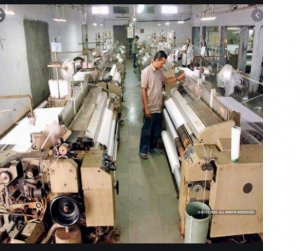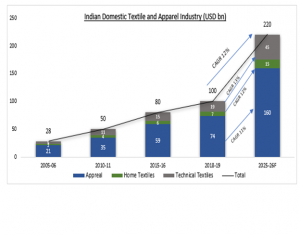Textile Manufacturing Business- Why to Invest in This This Business?
Business is growing at a splashing rate in India and new large scale industrialized businesses are opening up in different subdivisions to approve the make in India drive. But a thorough analysis of the market and mainly about the market and opportunities of a manufacturing or construction plant. Should be done by entrepreneurs before placing footsteps inside the industrial business. So we will be concentrating on giving a detailed report of the textile industry manufacturing business.
Related Projects:- Textile, Apparel, Clothing, Denim wear, Innerwear, Lingerie, Hosiery, Denim Jeans, Readymade Garments and Under Garments Industry.

The Indian textile industry plays a momentous role in the budget of the country. It is one of the largest suppliers to India’s export, about 13 percent of total exports. This industry also provides direct and indirect employment to about 105 million people. The textile industry is having constructive growth not only in the local market but also in the worldwide markets. With such development in this industry, the Indian Government is also given that all the help and support. This industry is prosperous like never before. This is the best period, to invest in this industry. There are so many opportunities obtainable for trading in the textile business
NPCS’ detailed strategy report aims to offer you all the communicative material required. The following are the essential facts of why setting up a textile manufacturing business.
- Essential Points to remember - Opening a textile unit firm means supply diverse types of fabrics for the fashion and attire industry. There are two methods of working in this case – either opening a factory that goods textiles or fabrics or a shop that sells textile products. In both cases, it is vital. The location of the unit is strategic. The factory should be in an area that is well linked and has no water and electricity-related issues and close to the basis of raw materials on the occasion of a factory Transport is critical and plenty of storage space that is well-aired because of fabrics leave toxic resources and dust after. Opening an industrial-scale business also requires a good amount of investment

- Market Trends - The textile industry is at the moment donating 2% to India’s GDP and 15% to the trade earnings of the country. The Indian textile industry is one of the major in the world with the chief part of land marked for cotton cultivation. India geographically is the largest producer of cotton, jute, and silk in the world approximately 95% of the weaving sector in India is unorganized in nature. The dispersed power loom and hosiery sector contribute 85% of total fabric manufacture There are facts such as promising policies and enticements for textile manufacturers, plentiful raw material, expert manpower in the country for the comprehensive value chain of textile manufacture has good predictions in India.
Related Projects:- Technical Textiles, (Agrotech, Buildtech, Clothtech, Geotech, Hometech, Indutech, Lifting Textiles, Mobiltech, Oekotech or Ecotech, Packtech, Protech, Sportech Textiles) Projects
- Challenges faced - challenges such as insufficient know-how, low focus on research, the revolution in new product expansion, and low technology upgradation. Further, low efficiency and mechanization levels are adding to despairs for the weaving industry. Due to these factors, the overall presentation of fabric production in India is getting diminished. The weaving sector still is one of the shortest links of the Indian textile and apparel industry. However, high pollution levels and poor quality of fiber, both in fineness and length, are major worries that need attentive care. India uses old technology with low productivity and quality levels. The cost of production in India also goes up due to unfortunate technology levels and low scale of operations, as 95% of the weaving sector in India is disorganized and on a small scale. India also lacks the presence of large fabric producers when linked to China and the US. India has a strong attendance in global spreads of cotton yarn. India needs to promote its position from a dealer of cotton yarn to a producer of value-added materials and garments.
Related Books:- Textile Spinning, Processing, Natural Fibers, Natural Dyes, Pigments, Textile Dyes, Pigments, Dye Intermediates, Woollen Spinning, Weaving, Knitting, Dyeing Technology
Indian Textile market Share Annually (2017-2019)
| S.No. |
Types |
2017-18 (%) |
2018-19 (%) |
2018-19 (%) |
| 1.0 |
Fashion and Clothing |
56 |
63 |
65.7 |
| 2.) |
Technical |
17.89 |
18.7 |
20.45 |
| 3.) |
Household |
12.56 |
10.6 |
11.89 |
| 4.) |
Others |
3.5 |
2.6 |
3.6 |
· Future Growth - industry needs to put emphasis on capitalizing in technology up-gradation and develop weaving capacity to scale-up operations. At current, the weaving sector is receiving subsidy at 10% subject to a cap of 20 crores under ATUFS, whereas for garments and practical textiles, finance is provided at 15% subject to a cap of 30 crores. For making few global winners in the weaving sector in India, state governments should violently promote substructure and deliver plug and play parks for the industry. Lands should be designated in such parks for lasting lease. The source of continuous quality power at a fixed price for a tenure of 15 years may also be promoted in these parks. To safeguard fast scaling up of business, state administrations should offer all the endorsements in these parks.
Related Videos:- Textile Industry
The weaving sector is the mainstay of the textile industry. Endorsing the weaving industry gives motivation to the domestic spinning industry and on the other, it makes our garment’ sector internationally more reasonable. With focused interventions in this sector, we might enhance its performance in terms of more investment, service generation, and export earnings. NPCS’s project consultancy and market examination fields put forward the developing possibility for textile manufacturing business on an industrial scale.
Tags:- #DetailedProjectReport #businessconsultant #BusinessPlan #feasibilityReport #NPCS #industrialproject #entrepreneurindia #startupbusiness #startupbusinessideas #businessestostart #startupideas #TextileIndustry #textileindustry #textilebusiness